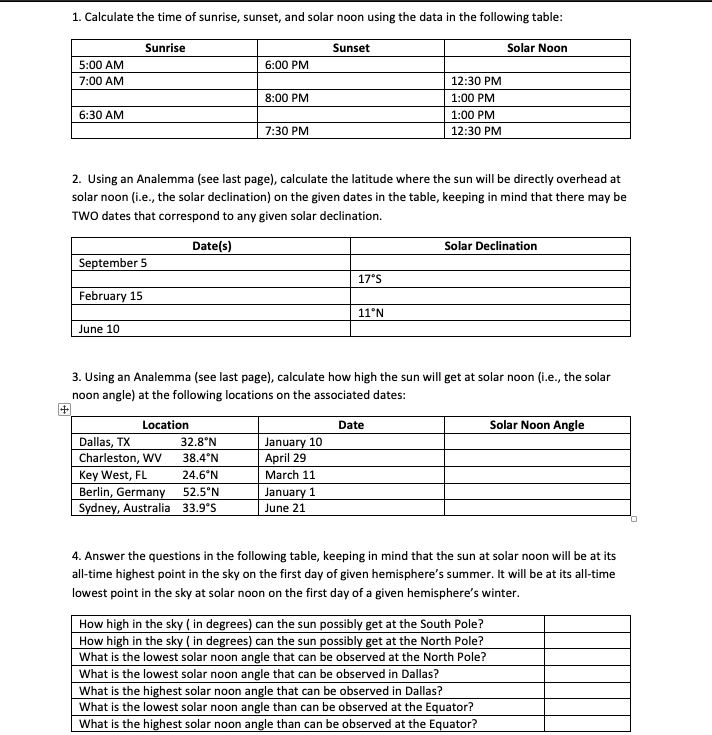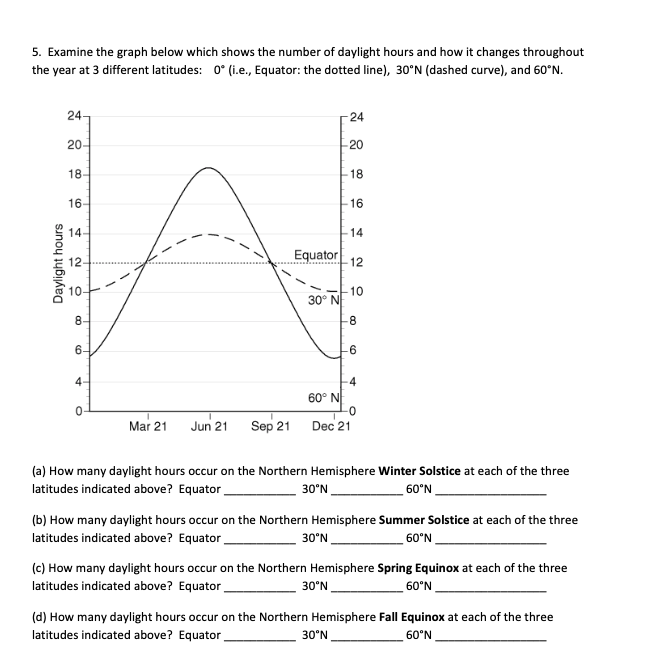Answered step by step
Verified Expert Solution
Question
1 Approved Answer
1. Calculate the time of sunrise, sunset, and solar noon using the data in the following table: 5:00 AM 7:00 AM 6:30 AM Sunrise


1. Calculate the time of sunrise, sunset, and solar noon using the data in the following table: 5:00 AM 7:00 AM 6:30 AM Sunrise September 5 February 15 June 10 Location 6:00 PM Dallas, TX Charleston, WV Key West, FL 32.8N 38.4N 24.6N Berlin, Germany 52.5N Sydney, Australia 33.9S 8:00 PM 2. Using an Analemma (see last page), calculate the latitude where the sun will be directly overhead at solar noon (i.e., the solar declination) on the given dates in the table, keeping in mind that there may be TWO dates that correspond to any given solar declination. Date(s) 7:30 PM Sunset January 10 April 29 March 11 January 1 June 21 17S 11N 3. Using an Analemma (see last page), calculate how high the sun will get at solar noon (i.e., the solar noon angle) at the following locations on the associated dates: 12:30 PM 1:00 PM 1:00 PM 12:30 PM Date Solar Noon Solar Declination How high in the sky (in degrees) can the sun possibly get at the South Pole? How high in the sky (in degrees) can the sun possibly get at the North Pole? What is the lowest solar noon angle that can be observed at the North Pole? What is the lowest solar noon angle that can be observed in Dallas? What is the highest solar noon angle that can be observed in Dallas? What is the lowest solar noon angle than can be observed at the Equator? What is the highest solar noon angle than can be observed at the Equator? Solar Noon Angle 4. Answer the questions in the following table, keeping in mind that the sun at solar noon will be at its all-time highest point in the sky on the first day of given hemisphere's summer. It will be at its all-time lowest point in the sky at solar noon on the first day of a given hemisphere's winter. 5. Examine the graph below which shows the number of daylight hours and how it changes throughout the year at 3 different latitudes: 0 (i.e., Equator: the dotted line), 30N (dashed curve), and 60N. Daylight hours 24 20- 18- 16- 14 12 10- CO 8- 6- 4- 0 Mar 21 Jun 21 Sep 21 Equator 30 N 60 N -24 -20 30N -18 -16 -14 30N -12 -10 -8 -6 -4 Dec 21 0 (a) How many daylight hours occur on the Northern Hemisphere Winter Solstice at each of the three latitudes indicated above? Equator_ 30N 60N (b) How many daylight hours occur on the Northern Hemisphere Summer Solstice at each of the three latitudes indicated above? Equator 60N (c) How many daylight hours occur on the Northern Hemisphere Spring Equinox at each of the three latitudes indicated above? Equator 30N 60N (d) How many daylight hours occur on the Northern Hemisphere Fall Equinox at each of the three latitudes indicated above? Equator_ 60N
Step by Step Solution
★★★★★
3.46 Rating (182 Votes )
There are 3 Steps involved in it
Step: 1

Get Instant Access to Expert-Tailored Solutions
See step-by-step solutions with expert insights and AI powered tools for academic success
Step: 2

Step: 3

Ace Your Homework with AI
Get the answers you need in no time with our AI-driven, step-by-step assistance
Get Started


